ringneckhunter1980
New member
Which species of spruce would make better pheasant habitat in the northeast US?
Thank you
Thank you
Depending on how dry your area is and your soil type should narrow your decision. I have good rain where I am at and my white spruce have done well. If you ever want Apple trees you don't want cedar trees as cedars cause cedar Apple rust which harms Apple trees.
Bumping an old comment as I’m curious how the dwarf Alberta spruce are doing? I like the relatively short height and am looking into getting these for my own property in WI. Where did you get your dwarf Alberta from? Having trouble finding a cheap source.Spruce vs cedar
Last year I planted 50 red cedars that went into the ground as dry root trees. I went with 10 foot spacing between trees and 8 foot between rows (probably should have been 10 foot between rows). This past weekend I counted 44 of the 50 looked like they had survived. I intend to plant two more rows this Spring next to the two existing rows.
We just planted a row of dwarf Alberta Spruce, this is a first attempt at planting spruce trees. I liked the idea of them only growing to 10-12 feet tall, unfortunately they grow slow, so it will take a while.
All of our other planting is bushes and a few apple trees.
The thought fighting the weather would be the hardest part about getting things to grow, but it's not.... its the deer.
SDviking
Plant species that are native to your area. Dwarf albertas are blue spruce and ornamental, they dont seem to grow well outside of the landscape environment. Native conifers would be your best bet.Bumping an old comment as I’m curious how the dwarf Alberta spruce are doing? I like the relatively short height and am looking into getting these for my own property in WI. Where did you get your dwarf Alberta from? Having trouble finding a cheap source.
Unfortunately painfully slow like 6 inches a year maybe. They also fight sun damage in the wintertime when they get dry. I'm nursing mine along but not sure how they will fair after I stop helping them along. I got mine at Lowes, just got lucky I guess. If you ask your conservation district they can sometimes be very helpful in finding a good local nursery.Bumping an old comment as I’m curious how the dwarf Alberta spruce are doing? I like the relatively short height and am looking into getting these for my own property in WI. Where did you get your dwarf Alberta from? Having trouble finding a cheap source.
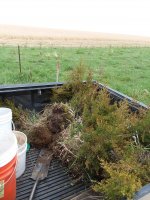
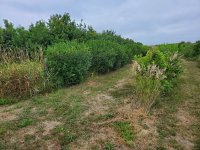

Wow really like the second photo! Makes me want to go cottontail hunting. I have an old shelter belt with the traditional two rows of lilocs and another bush on the south, three rows of ash (which are dying) and then two rows of liloc and some other bush on the north side. they planted the rows about 8 foot apart and trees in my opinion are too close together (6 to 8 feet). As I remove the ash I am replacing with oaks, thornless hawthorne, Honeysuckle all mixed up in one row. The other two rows are evergreens, Junipers and Red Cedars do ok in the shade so far along with Black Hills Spruce. Its a super slow process due to the shade from the existing trees and fighting with the roots that exist. Photo below shows a half dozen hens this morning soaking up the sun. Can't wait for the evergreens to get established to provide better winter support.Iowa DNR has the State Forest Nursery that sells trees here. Maybe SD does also and . I have planted hundreds from them and have had good luck with them. They come bare root and if you get a wet spring/summer the year you plant them and the following year, you should be good. Dry years, you need to consider watering to get them established. Creating good habitat often is not easy.
When I just need a few "fill-in" trees I will dig some ditch cedars (about 2 feet is as big as you will want) as close to me as I can find. These eastern red cedars might be the easiest to grow and will provide nice shelter in the winter blizzards.
The pic below was May 2019, the background is rows of shrubs planted in the spring of 2016. The bottom pic is those shrubs in summer of 2022. It takes some babying of those in the first few years, but they take-off eventually! The far left are wild plum, then aronia berry, then hazel nut and gray dogwood you can see on the far right. The plums grow fast and most plants start spreading (suckering) to form a nice thicket.
There were about 1,300 shrubs planted that spring, (rented a pull behind tree planter from the county, finished in a morning). Weed whipped around them and mulched them for maybe 3-4 years. Did rig-up a single nozzle on the gator and sprayed a herbicide mix for a couple more years (should have done that much earlier!) that kept the weed competition down....do this to make your life easier! If you have access to a machine to lay the fiber mat or plastic down, that would likely be better yet...not sure what that cost might be, but we would have needed over a mile for this project.
View attachment 5318
This past summer
View attachment 5319
There is more than 150 acres of different grasses to nest in, but here was a successful nest hatch, I saw right in these shrub rows. We finish mow between the rows, kind of for 2 reasons, first to keep the weed competition down for the shrubs (reason for the county DNR) but it also makes great travel corridors for young chicks with easy access to overhead cover. By the time fall comes, the ground under the plums is pretty much bare dirt from the traffic lane it provides. I love creating habitat and seeing the results!
View attachment 5320
I just realized this is an ancient thread from an extinct member! But to the OP's general question, if you have deer, chose something the they might leave alone and native to your area. I think you really need some conifers somewhere close to make great habitat. I find myself adding at least a few conifers (usually ERCs) every year.
Nice looking planting! Any winter pics? I ordered some American Plum this year and am surprised at the size of yours after only a few years. I didn't realize they got that large.Iowa DNR has the State Forest Nursery that sells trees here. Maybe SD does also and . I have planted hundreds from them and have had good luck with them. They come bare root and if you get a wet spring/summer the year you plant them and the following year, you should be good. Dry years, you need to consider watering to get them established. Creating good habitat often is not easy.
When I just need a few "fill-in" trees I will dig some ditch cedars (about 2 feet is as big as you will want) as close to me as I can find. These eastern red cedars might be the easiest to grow and will provide nice shelter in the winter blizzards.
The pic below was May 2019, the background is rows of shrubs planted in the spring of 2016. The bottom pic is those shrubs in summer of 2022. It takes some babying of those in the first few years, but they take-off eventually! The far left are wild plum, then aronia berry, then hazel nut and gray dogwood you can see on the far right. The plums grow fast and most plants start spreading (suckering) to form a nice thicket.
There were about 1,300 shrubs planted that spring, (rented a pull behind tree planter from the county, finished in a morning). Weed whipped around them and mulched them for maybe 3-4 years. Did rig-up a single nozzle on the gator and sprayed a herbicide mix for a couple more years (should have done that much earlier!) that kept the weed competition down....do this to make your life easier! If you have access to a machine to lay the fiber mat or plastic down, that would likely be better yet...not sure what that cost might be, but we would have needed over a mile for this project.
View attachment 5318
This past summer
View attachment 5319
There is more than 150 acres of different grasses to nest in, but here was a successful nest hatch, I saw right in these shrub rows. We finish mow between the rows, kind of for 2 reasons, first to keep the weed competition down for the shrubs (reason for the county DNR) but it also makes great travel corridors for young chicks with easy access to overhead cover. By the time fall comes, the ground under the plums is pretty much bare dirt from the traffic lane it provides. I love creating habitat and seeing the results!
View attachment 5320
I just realized this is an ancient thread from an extinct member! But to the OP's general question, if you have deer, chose something the they might leave alone and native to your area. I think you really need some conifers somewhere close to make great habitat. I find myself adding at least a few conifers (usually ERCs) every year.
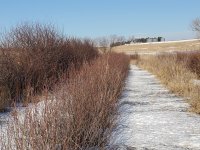
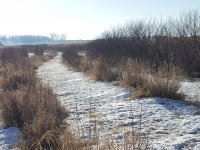
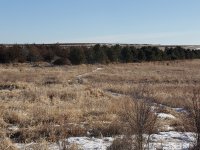
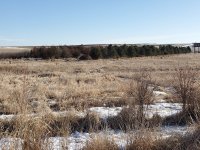
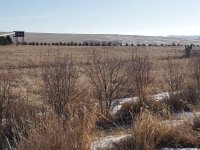
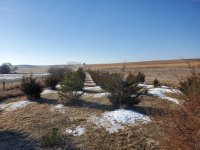
Is your hedge row actual hedge?Took a stroll today and and got a few winter pics. Saw maybe 50 birds flush. The cover looked good, the mixed native grasses looked better that the switchgrass as the switch was burned off last spring and doesn't have the understory.
A couple shoots of the hedgerow.
View attachment 5325View attachment 5326
Some shelter belt pics of our older stand, planted 2007 & 2008
View attachment 5328View attachment 5327
Newer addition to shelterbelt, it is starting to get some size, planted these 2017 & 2018
View attachment 5329
View attachment 5330
That's what I thought it looked like. Here The term Hedge rows were Osage orange. Not many left today.If you mean a row of shrubs planted close together, yep. If you mean a specific shrub other than plums, dogwood, hazelnut, arrow wood or aronia berry planted close together, well then no. The plums are hard to get through, I have 3, 40 foot breaks, in the rows, they run for about 1950 feet, have a 30 foot wide food plot between it and the switchgrass.
